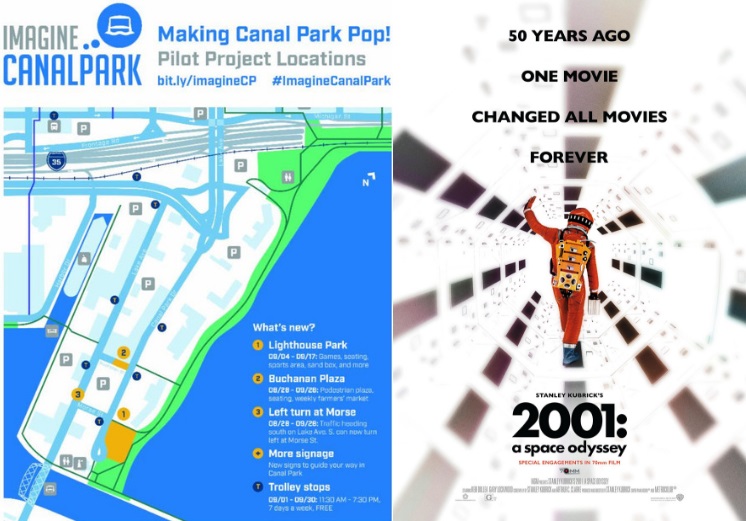I spent part of Friday at Make Canal Park Pop! and Saturday at 2001: A Space Odyssey. The events felt oddly similar, and my experience of both was disjointed if not entirely cynical.
So, the first impact of the changes to Canal Park seems to be making Canal Park Drive — the road on which the bulk of hotels reside — a cul-de-sac. I’m not sure for whom this is a benefit; perhaps visitors to the hotels? Locals headed to Park Point or to the restaurants must now take Railroad to Lake, which I guess works, if your primary goal is to funnel local traffic to one road and tourist traffic to another one? In my case, it also served to push my local traffic onto the alley behind the Caribou/Plaza, all the way through to Dewitt-Seitz, the first few times I realized that I missed the turn onto Railroad Street.
The signage looks nice, although the large ones look like they won’t survive the Gales of November. The events in the Lighthouse parking lot are, well, events in a parking lot. I would have enjoyed them more if they had been on the grass. It was hard getting friends to visit the events with me, because eliminating parking in Canal Park in September decreases its attractiveness even more.
If I could have created a musical score for this event, I would have chosen “Thus Spoke Zarathustra,” echoing with a new vocal: “Why, why, why?” over the three notes at the start.
This is perhaps fitting because I spent Saturday night watching 2001: A Space Odyssey at Zinema 2, in honor of the movie’s 50th anniversary.
Fifty years is a long time. Long enough that, instead of computer-generated imagery, rubber masks and fur suits were acceptable as apes — as this movie and as Planet of the Apes would show.
It is fascinating to place myself in the headspace where this can feel real — where the multimillion dollar movie functions, really, like theater. In theater, a red kerchief becomes blood and a rubber mask becomes flesh. So, too, for apes in the 1960s.
That said, the movie irks me because of the way it offers an anthropology antithetical to my own values. The monolith sparks human development at the “Dawn” of history. The monolith sparks human exploration of the solar system. The monolith pushes us again at the film’s end.
In some ways, it’s reflective of the “Chariots of the Gods” thesis. I’m not the first one to see this; see for example this blog post. What we are is not intrinsic to us, but a result of the engineering of alien beings, alien gods.
I’m not there. What is magical about us is not how we are touched by aliens or gods, but by each other.
That said: The last twenty minutes are right up there with Jefferson Airplane videos for pointless psychedelia. See:
… as opposed to …
… for the snarky part of my feelings. Psychedelia. Not for me.
The showing was sold out, and I was happy to be in so much good company for what were really three movies:
- a decent movie about a killer space ship
- an engaging short film if read as a prequel to Planet of the Apes
- a 20-minute psychedelic credit sequence I could have missed entirely without sadness
It is doubly disappointing when you think about what could have been. After all, the Stargate sequence was generated with the same technology that generated the greatest TV show opening of all time, a TV show that depicts aliens as they should be: manifesting the “the triumph of intellect and romance over brute force and cynicism!”
Aware of my own cynicism, I’m going to go watch some Doctor Who to cleanse the palette.
